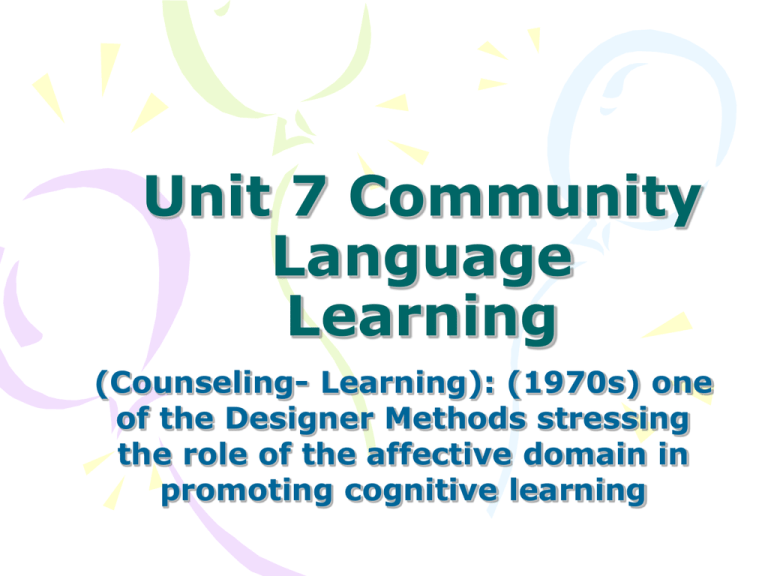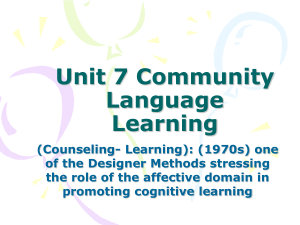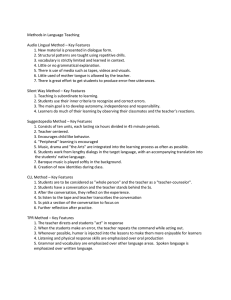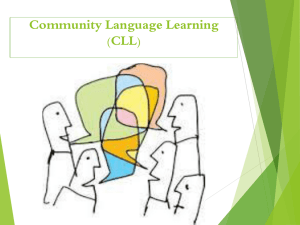Unit 7 Community Language Learning
advertisement

Unit 7 Community Language Learning (Counseling- Learning): (1970s) one of the Designer Methods stressing the role of the affective domain in promoting cognitive learning Origin • CLL was developed by Charles A. Curran and his associates in Chicago, 1955. It is sometimes cited as an example of a humanistic approach and derives its primary insights from counseling. • With that, the roles of the teacher are the counselor and learners, the clients. The counselor does not automatically assist the clients but passively offer his help to them. CLL involves humanistic techniques which engage the whole person, including the emotions and feelings as well as linguistic knowledge and behavioral skills. • Influenced by Carl Roger’s humanistic psychology, Curran found that adults often feel threatened by a new learning situation or fear that they will appear foolish. • A way to deal with the fears of students is for teachers to become language counselors, skillful understanders of the struggle students face as they attempt to internalize another language. Principles • Learning is persons: human individuals need to be understood and aided in the process of fulfilling personal values and goals; this is best done in community with others striving to attain the same goals; whole-persons learning in a relationship of trust, support, and cooperation between teacher and students and among students Principles • Learning is dynamic and creative: learning is a living and developmental process Building a relationship with and among students is important as well as lessening their fears to a new learning situation. Teachers do not remain in the front of the classroom to reduce threat to them. To let students feel secure facilitates their learning such as use of L1, more cooperation in the community, understanding what will happen in each activity and so on. Characteristics • a conversation in a beginning class in L1 with translation of the teacher and later on transcription • students sitting in a circle with a tape recorder: a dependent community to cooperate with each other rather than compete with each other. • teachers as counselors and students as clients: sensitive to students’ feelings and fears • six elements necessary for nondefensive learning: security, aggression, attention, reflection, retention and discrimination Influences • the role of teachers as counselors who understand and assist students to help them overcome the threatening affective factors • emphasis of classroom interaction in cooperation, not competition • respect for students’ choice of learning content with a learner-generated conversation • no translation but for Ss to induce rules Drawbacks • The procedure doesn’t ensure that a variety of contexts necessary for coping in the target culture is included since the content is determined by the participants. • Students may feel uncomfortable with the apparent lack of structure or sequence in the introduction of grammatical and lexical items; that is too much reliance on an inductive strategy of learning. Besides, there is no syllabus for CLL, a posteriori approach to syllabus specification. The teacher is too nondirective. Finally, the success of CLL depended largely on the translation expertise of the counselor. 10 Questions to be answered • What are the goals of teachers who use the CLL method? -- To learn how to use the target language communicatively in a nondefensive manner • What is the role of the teacher? What is the role of the students? T—a counselor; S—a client The relationship between T and S from dependency to independency through five stages (focus of fluency or accuracy) • What are some characteristics of the teaching/learning process? a conversation in L1-> translation in chunks recording of the conversation a transcript with L1 equivalents activities based on the conversation • six elements necessary for nondefensive learning security—non-threatening learning environment aggression—actively involved in the learning experience attention—ability to attend to many factors simultaneously by narrowing the scope of attention initially reflection—when Ss reflect on the language as the teacher reads the transcript three times; when Ss are invited to stop and consider the active experience they have retention—the integration of the new material that takes place within the whole self discrimination—sorting out differences among target language forms such as Human Computer • What is the nature of studentteacher interaction? What is the nature of student-student interaction? S-T first and S-S interaction afterwards; teacher-studentcentered with both being decisionmakers in the class • How are the feelings of the students dealt with? Inviting Ss to comment on how they feel to keep their security • How is language viewed? How is culture viewed? Language for communication in a supportive learning process; culture as an integral part of language learning • What areas of language are emphasized? What language skills are emphasized? Grammar points, pronunciation patterns and vocabulary based on the language Ss generate; the importance of understanding and speaking the language at first, then reading and writing • What is the role of the students’ native language? L1 to enhance students’ security as a bridge from the familiar to the unfamiliar; literal L1 equivalents but less L1 in later stages • How is evaluation accomplished? An integrative test rather than a discretepoint one such as writing a paragraph or an oral interview or self-evaluation too • How does the teacher respond to student errors? T repeats correctly what Ss say incorrectly without calling further attention to the error Summary(Charles Curran, 1972) • A counseling-learning model in which non-defensive learning is achieved with six elements (security, aggression, attention, reflection, retention, and discrimination) and learners are considered “whole persons.” It aims at building a supportive community of Ss to interact in an interpersonal relationship, to lower defenses, and to meet learner needs. • The principles of discovery learning, student-centered participation and development of student autonomy (independence) remain viable in the application to lg classrooms. But it was too restrictive for institutional lg programs. Teachers are too non-directive, and their translation expertise determines success. Finally, there is too much reliance on an inductive strategy of learning. • http://www.cettaiwan.com/Epaper/200506_40_3.htm






